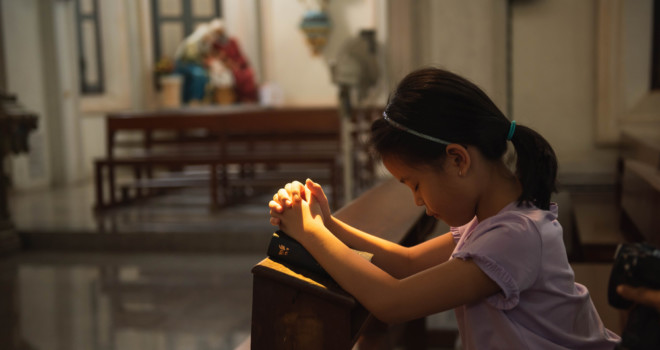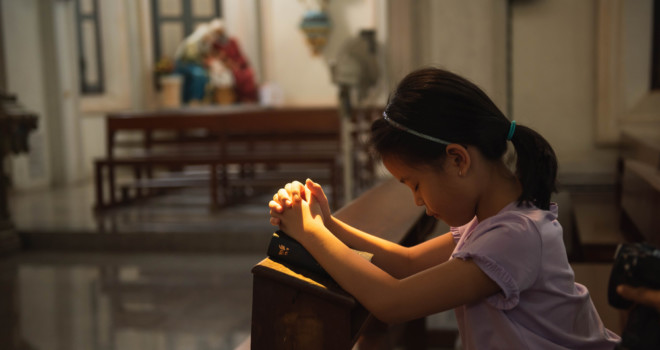The other day, I had a friend of mine text me about her child, who has anxiety and struggles with certain “scarier” aspects of Catholicism. Let’s be honest—at face value, there are a lot of things about our faith that could seem scary at first to a child—relics, martyrs, etc. But, in the proper context, we can understand these things to be part of the gifts of the Church, and to be a cause for courage rather than fear.
I have children who have faced anxiety as well and have worked as a catechist with children with a variety of unique needs and challenges, including mental health diagnoses. Maybe your child has been diagnosed with anxiety, depression, or obsessive-compulsive disorder. How can you teach them about the riches of our faith without omitting anything or watering anything down?
The key is in focusing on relationship.
Catechizing with Love
For years I worked with children with special needs, doing both general catechesis and sacramental preparation with them. One of the foundational tenets of my catechetical beliefs is that it is essential that children (especially those with special needs) have time with Jesus in the Eucharist. Catechetical work is not, primarily, a work that we accomplish. It is the work of God in the heart of each child. It is so important to teach our children all about the richness of Catholic doctrine, but it is meaningless if we don’t lead them to an encounter with Christ. Taking children and bringing them to Jesus in the tabernacle allows him to form a relationship with them without interference. If they are given the time and space to love and be loved by him, children will be much more receptive to learning about the teachings of the faith. It will no longer be empty memorization—it will be part of the process of falling in love with God.
From the time my own children have been babies, I have taught them to blow kisses to Jesus in the Eucharist. I have built on that practice over the years, encouraging them to come freely to him in the tabernacle, knowing that they are loved and wanted by him.
Any other catechesis that I do with my children (or that I have done previously with students of mine) has flown naturally from that relationship of love. Sin and the need for repentance—concepts that can lead a child with anxiety or other mental health diagnoses to become scrupulous—are less scary when framed in the context of loving relationship. What makes sin scary is not that God will be offended and punish you. What makes sin awful is that it hurts the one who loves us the most, and who is most deserving of our love. Healthy guilt is not immobilizing (the way the guilt of scrupulosity is) but rather spurs us gently and firmly back to God and the sacraments.
Virtually every aspect of Catholic doctrine can be viewed through the lens of relationship with God and the Church—the Sacraments, vocations, the Mass, etc. Besides the Eucharist, though, the other piece of doctrine most beautifully conveyed through relationship is the Communion of Saints.
Catechizing with the Saints
I have three daughters, and the youngest is spoiled to excess by her big sisters. Often, when I am trying to discipline her—sometimes for some offense against her big sister—one of my older girls will step in and try to defend her or comfort her. She can do (almost) no wrong in their eyes. She is loved and she knows it.
In teaching my children about the saints, I have often referred back to that lived experience. Even for a child without siblings, a little one will have likely experienced at some point what it felt like to be the youngest in the room. The baby of a family is treated with particular patience and attentiveness.
So it is with us and the saints. Since we are brothers and sisters in Christ with the saints, we can rightly claim the role as their baby brothers and sisters. (My daughters love the fact that they AND Mommy are all baby sisters to Jesus and the saints!) St. Therese of Lisieux understood this well, and often would ask for the intercession of her older biological siblings who had died before her birth. Her view was that if she were their baby sister, surely, they would have a tender place in their hearts for her. The beauty of baptism is that it binds us even more closely than biological bonds. It isn’t just like we are the baby brothers and sisters to the saints. We are their baby siblings!
The reality is that many saints were afraid or suffered from mental health conditions (St. Therese of Lisieux actually had severe anxiety as a child, as well as possibly OCD manifested as scrupulosity). And many other saints faced things that were scary. When learning about the saints with an anxious child we can both affirm how scary some of those things were (martyrdom is a scary thing to learn about!) while also looking to our big brothers and sisters in the faith and asking them to pray for us, that we might draw on the same source of comfort that they did. The saints were able to face scary things because they knew that Christ had conquered the darkness! Surely, the saints will rush to the side of an anxious child.
Doctrine and Love
In one of my classes in graduate school, we studied the history of catechesis. In pouring over children’s religion textbooks from the past hundred years, it was obvious that there had been a period of “catechetical fluff” from the 1970s-1990s. (Thankfully, many Catholic curriculum makers have remedied that over the past couple of decades.) The primary message in those decades was simply, “God loves you!” I think that, because of that time of watered-down catechesis, many parents and catechists ardently desire that their children and students are not given a watered-down catechesis.
But the message of God’s love does not need to signify watered down doctrine. Rather, that message should be at the core of all other teachings. Children, by right of their baptism, deserve a robust, rich presentation of our Catholic faith. But that catechesis can be offered within the context of love, and with an eye to a relationship with the God who loves every child of his.
✠













